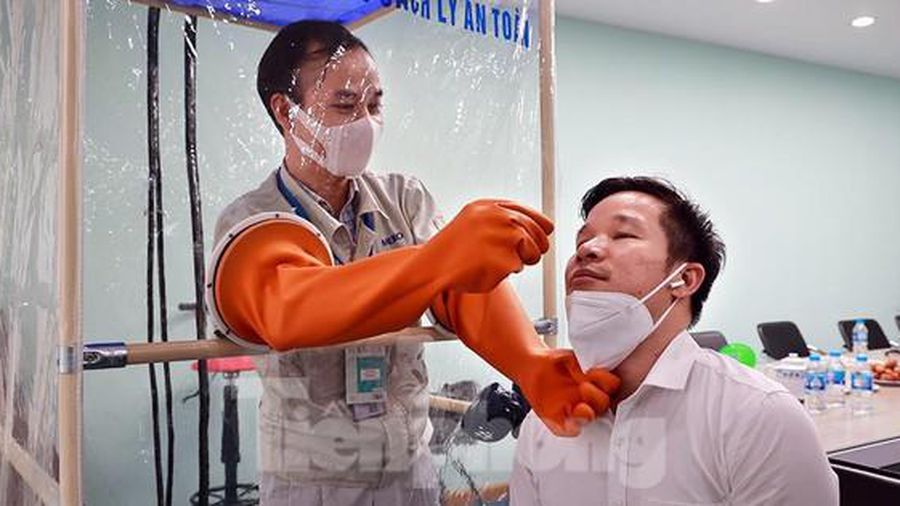Official: WHO recognizes new worrying COVID-19 variant Omicron
During a surprise meeting last night, the World Health Organization (WHO) assessed the new COVID-19 strain they discovered in South Africa and classified it as a variant of concern (VOC). This variant has been named Omicron and officially joins the list with the previous Alpha, Beta, Gamma and Delta strains.
"The Technical Advisory Group on the Evolution of the SARS-CoV-2 Virus (TAG-VE) was convened on November 26, 2021 to evaluate the SARS-CoV-2 variant: B.1.1.529" , WHO said in a press release.
"Based on the evidence presented showing adverse variability in the epidemiology of COVID-19, TAG-VE recommended that WHO designate this variant as a variant of concern, and WHO B.1.1.529 is called VOC, named Omicron".

TAG-VE is a group of independent WHO experts tasked with periodically monitoring and evaluating the evolution of the SARS-CoV-2 virus. At the same time, they are also constantly assessing whether specific mutations and combinations of those mutations change the behavior of the virus.
The results of their evaluation of the new variant Omicron showed that it has a large number of mutations, many of which are worrisome. "Preliminary evidence suggests an increased risk of reinfection with this variant compared with other VOC variants of concern. The number of cases of this variant appears to be increasing in most provinces in South Africa.
Current PCR diagnosis of SARS-CoV-2 continues to detect many infections with this variant. Several laboratories have pointed out that the currently commonly used PCR test is unable to detect one of the three target genes (so-called neglected or untargeted S gene).
Therefore, this assay can be used as a marker for this variant pending confirmation of the genomic sequence. Using that approach, this variant was detected at a faster rate than in previous infections, suggesting that the new variant may have a growth advantage," WHO wrote in a statement. newspapers.
"There is some urgent research underway and TAG-VE will continue to evaluate this variant going forward. WHO will communicate its new findings to Member States and the public as needed. ".
Recalling the characteristics of a VOC variant of concern in the WHO rating scale, Omicron achieved the following criteria:
1. There are genetic changes predicted or known to affect viral characteristics such as: transmissibility, disease severity, immune evasion, diagnosis or treatment.
2. Causing significant community transmission or outbreaks of multiple clusters of COVID-19, in multiple countries with increasing relative prevalence coupled with increasing number of cases over time.
3. There may be other obvious epidemiological effects to suggest a new risk to global public health

In response to this new VOC variant, WHO recommends countries:
- strengthen surveillance and sequencing efforts to better understand circulating SARS-CoV-2 variants.
- submit the complete genome sequence and associated metadata to a publicly available database, such as GISAID.
- report initial cases/clusters related to VOC contamination to WHO through the IHR mechanism.
- when competent and in collaboration with the international community, conduct field investigations and laboratory assessments to improve understanding of the potential effects of VOCs on COVID-19 epidemiology, levels of severity, effectiveness of social and public health measures, diagnostic methods, immune response, neutralizing antibodies, or other relevant characteristics.
Individuals are reminded to take precautions like 5K to reduce their risk of COVID-19, including: wearing masks properly, washing hands frequently, keeping physical distance, improving indoor ventilation, avoiding crowded spaces and fully vaccinated.
You should read it
- More than 540 studies, 80 clinical trials and 200 viral genomes: The scientific system is working at full capacity in the Covid-19 epidemic.
- SARS-CoV-2 virus lives from 4 hours to 3 days in the environment but will be killed in just 1 minute with
- 5 differences in the way against the Covid-19 pandemic in Viet Nam were commended by WHO
- How does Covid-19 infect lung cells? Why is it so dangerous?
- What is pandemic? When does WHO announce an epidemic as a pandemic?
- Taking Covid-19 virus image at atomic resolution, scientists discovered its chemical infectious nature
- Scientists discovered the weakness of SARS-CoV-2 virus
- Research from 3 scientists: 40 measures to combat Covid-19 in a timely, effective manner, to stop epidemic peaks, not to cause hospital overload
May be interested
- New variant of ransomware Arena Crysis appeared
 researcher michael gillespie has discovered a new variant of ransomware crysis / dharma that adds the .arena extension to the encrypted file.
researcher michael gillespie has discovered a new variant of ransomware crysis / dharma that adds the .arena extension to the encrypted file. - How to block Specter Variant 2 Patch on Windows 10
 microsoft has released a windows 10 kb4078130 update to disable patches for two meltdown and specter vulnerabilities that caused a reboot problem on some devices. however, if you do not want to waste storage space, users can adjust themselves without having to download additional kb4078130.
microsoft has released a windows 10 kb4078130 update to disable patches for two meltdown and specter vulnerabilities that caused a reboot problem on some devices. however, if you do not want to waste storage space, users can adjust themselves without having to download additional kb4078130. - 8 worrying signs that you need to rest immediately
 don't be subjective when you feel tired, the 8 worrying signs below tell you to take a break immediately!
don't be subjective when you feel tired, the 8 worrying signs below tell you to take a break immediately! - Please download the free Covid-19 icon set for the design
 iconfinder's covid-19 icon set includes over 300 free vector icons related to hygiene and awareness of the spread of viruses.
iconfinder's covid-19 icon set includes over 300 free vector icons related to hygiene and awareness of the spread of viruses. - The new Specter vulnerability appears to be a new variant that easily 'crashes' secure partitions created by Intel SGX
 researchers from the ohio state university have discovered a new dangerous variant of the specter vulnerability called sgxpectre with the ability to exploit information from safe partitions created by intel sgx.
researchers from the ohio state university have discovered a new dangerous variant of the specter vulnerability called sgxpectre with the ability to exploit information from safe partitions created by intel sgx. - Program 55 billion to support businesses degraded by Covid-19
 on february 22, 2020, goldsun communications group officially launched the 'covid-19 shield' program to support vietnamese businesses that are struggling due to the covid-19 epidemic.
on february 22, 2020, goldsun communications group officially launched the 'covid-19 shield' program to support vietnamese businesses that are struggling due to the covid-19 epidemic. - Conficker.e started to implement 'money-making mission'
 last night (9/4), there was a new variant of conficker worm, which continued to carry out the unfinished 'mission' that conficker.c could not do in the last april fishing day.
last night (9/4), there was a new variant of conficker worm, which continued to carry out the unfinished 'mission' that conficker.c could not do in the last april fishing day. - These heartless scams take advantage of Covid-19 in China
 many crooks see the covid-19 epidemic as an opportunity to lure many 'prey' and profiteering from the bewildered, frightened psychology.
many crooks see the covid-19 epidemic as an opportunity to lure many 'prey' and profiteering from the bewildered, frightened psychology. - A funny moment of Covid-19 season in Hue: Homemade robots from toy cars roam around providing relief for patients
 a simple invention of the covid-19 campaign, but no less subtle, has made many people surprised and admired for its creativity.
a simple invention of the covid-19 campaign, but no less subtle, has made many people surprised and admired for its creativity. - 5 differences in the way against the Covid-19 pandemic in Viet Nam were commended by WHO
 according to deputy health minister nguyen thanh long, if he is not determined to prevent covid-19 from invading, it will be difficult for the epidemic to spread in the community.
according to deputy health minister nguyen thanh long, if he is not determined to prevent covid-19 from invading, it will be difficult for the epidemic to spread in the community.









 7 best foods to help control cholesterol
7 best foods to help control cholesterol Decoding recurring dreams from a psychological perspective
Decoding recurring dreams from a psychological perspective 7 harmful effects of smartphones on human health
7 harmful effects of smartphones on human health COVID-19 Portable 'safely isolated sampling chamber' in Vietnam
COVID-19 Portable 'safely isolated sampling chamber' in Vietnam Steps to filter blue light on PC, Laptop to protect eyes
Steps to filter blue light on PC, Laptop to protect eyes Can't sleep what to do? 23 ways to help you sleep early 100% success
Can't sleep what to do? 23 ways to help you sleep early 100% success